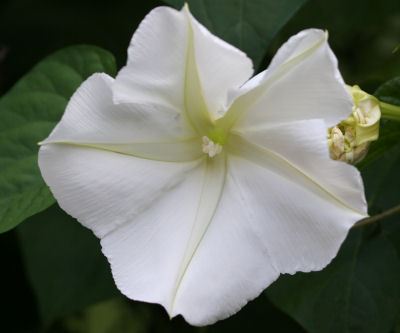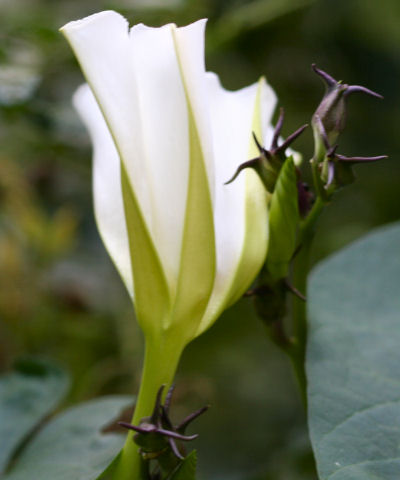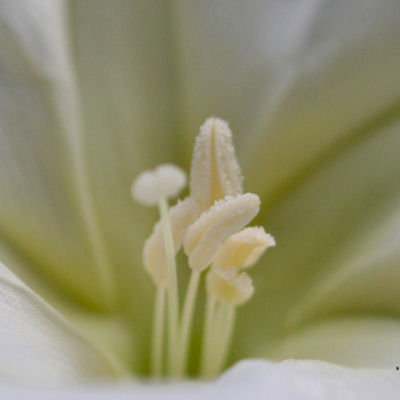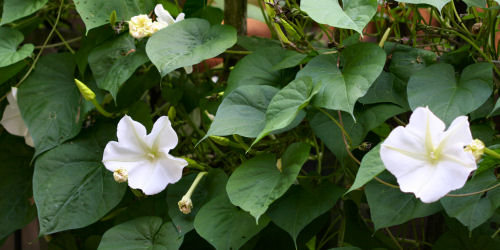This year, like most years, my father planted some Moonflowers (Ipomoea alba), hoping they would grow up the cedar trellises, built by my late grandfather, that stand against the railing on my folks’ back porch. And, unlike most years, he’s had a bumper crop of the giant, fragrant, nocturnal blossoms, topping out at 15 in one night. Sitting on the porch in the evening listening to a distant Carolina Wren singing is now made all the better by the pervasive scent of the gorgeous, moth-pollinated flowers.

To take advantage of the moths that pollinate them, Moonflowers, sometimes referred to as Moon Vines or Giant White Moonflowers, open in the evening and curl up and die when the sun rises. While they last they fill the air with a wonderful smell, again, not meant for human enjoyment, but to attract moths. But one needn’t be a moth to appreciate their delicate and quickly-passing beauty.

The Moonflower above is just opening, a process that occurs remarkably quickly. In fact Moonflowers open in about one minute’s time. You can see one opening in this video. Their lush, large-leaved vines flourish in the direct sunlight that the blossoms avoid and can be grown anywhere their close relative, the Morning Glory, grows. And, though eating their seeds does not cause hallucinations like the Morning Glory’s seeds do, they are poisonous if ingested.

stamina of the Moonflower
So if you have an ugly fence or something else you want covered up with some nice climbing foliage consider the Moonflower. You won’t regret it and neither will your neighborhood moths.














I saw a Sphinx moth on one of these at Beth’s uncle’s house.
Guess what?-I’ve got an ugly fence I want covered up!-Neat video and post.
Just an update, the moon flowers had slowed down to 3 or 4 a night , but with the recent warm weather we are back to around 8 -10 a night. Last night my wife and I watched several of these beautiful flowers spread their petals to the sky. I almost think I know now how Mr Wilson in Dennis the
Menace felt awaiting the midnight blooming of his rare flower.
I have found a type of moon Flower growing on a lease wild. It has the same flowers, only opens at night, and smells wonderful, but it is not a vine. Is it just another type or something else?
@Mel Mel: I’ve never heard of a moonflower growing on anything but a vine…but if you manage to get some pictures maybe I can help figure it out…
Hi Corey,
I was soaking some moonflower seeds overnight and one of my cats may have drank a little of the water in the bottom of the bowl when I drained them this morning. I don’t know; he’s a curious one. Might that have hurt him? What symptoms should I look for? And how soon would problems start to develop? Please reply.
@Roger: That would be a veterinary question: I have no idea.
hi corey =)
my close friend loves moonflower, and i want to get it for her as birthday present. however, i don’t know where i can find the plant/seed =( can u please help me?
thanks!
@oxymoron: Google it. It should be relatively easy to find.
Amazing stuff. Never heard about Moonflower before. Just bought 3 at nextdoor village fete to replace my Morning glory which died while I was abroad. I got worried I bought bindweed which I fight most of the time :o) Do I understand well than I have to treat Ipomea Alba as annual here in England?
@Marie: Thanks, and yes, they are an annual.
we had some moonflowers about three years ago and there was this big moth like insect sort of like a hummingbird there were about ten or more.
Now i know they were the Sphinx Moth by browsing the web the past few days .i learned alot more about these amazing flowers.
Mel Mel. The shrubby version you saw is also called Moon Flower but it is one of many “Daturas” that are easily grown if you can find someone who has one. The flowers are very large and open with a strong perfume at sunset and night. Unlike many other Datura species that hang their flowers this one has flowers that point up to the sky. Sorry I don’t know the species name; I’ve been trying to get hold of one for years having grown successfully in North New Zealand I want to obtain it here in Australia where I’ve now made my permanent abode.
I saw this flower for the first time a week ago… The gal at the green house gave me two seed pods… I can’t wait for spring 2010! I want these to grow up an older crab apple tree that is along a sidewalk. I am way to excited… is there anything I need to know??
@Roxanne: I can’t think of anything in particular other than to enjoy those moonflowers!
Corey~
I opened the moonflowers seed pods last fall and put all the seeds into a baggie with sand in it I left the baggie open all winter hanging in a dark basement closet. I want to get a start on growing them. I live in Iowa. We have had apx 60 inches of snow this winter. When? Where? and How can I safely start my new moonflower seeds? what type of soil ect…?
@Roxanne: I would ask the folks at the greenhouse you got the seeds from: though I like moonflowers, birds are really where my expertise lies. Good luck!
help me please? i moved 2 years ago from WV and i had what i thougt was called moon flowers. i now live in AR. and lost my seed in the move. what i have bought here are not the same. this are moonflowers that vine. the ones i am looking for are on long stems that kind bush out and grow very tall. i would love to have them again but every one here do’s not know what i am talking about. is there any one how can help please email me at jkjoskat@gmail.com.
hey steve do u no why kids around wher i live like to take my plant i wake up every day an more an more is gone off of it email me bout that some guys told me they trip off of them an i would like to no what they trip off of i googled it an it dont say nothing
Thanks for this post, which ID’ed these for me. I photographed some at Jefferson Market Garden in the East Village. Would love to go birding sometime.
Beautiful..but are they invasive like their relatives the morning glories?
I just have one question, I’m doing a report on endangered species for my science class and I had heard that Moonflowers were rare. So are they or not? I’m confused. Please help me.
I have moon flowers that aren’t a vine they are a bush with thick stalkes and the seeds are in a prickley ball They bloom in the evening are these still moon flowers or something else. I have pictures of them.
I love growing moonflowers and this year my plants have a ton of buds. The problem I am having is the buds look like they should open up, but they just shrivel up and die. Any suggestions.
I seem to have planted these inside at the wrong time of year…?
Is their a way that I could pollinate this plant by hand?
I’m afraid if I leave it outside for moths to pollinate that it could get
damaged by the frost?
Moonflowers were my late husband’s favorite flower. We owned a bed and breakfast and when he would welcome female guests arriving in the evening, he would pluck a moonflower and give it to them. Needless to say, they were charmed. I have sold the B&B, but in his memory, I kept the seeds from our last plants and planted them in my new home. They bloom profusely here in North Carolina, with 10-15 blooms on the plant at a time. I have to plant them in a huge pot on my deck to keep the deer from eating them. I harvest the seeds every fall and plant them again every spring and have always have good luck with them. I have given seeds to lots of friends and former B&B guests all over the south. I think my husband would be pleased.
I stumbbled across tje flowered plant that mel mel was speaking of. its only about 2 feet tall and spreads out pn the ground. im located in central oklahoma.
LOL! One of these plants randomly grew in my front yard, and I noticed they only bloom at night. I end up here to find that it is called a Moon Flower. They are so fascinating and do smell amazing. Now that the West Nile virus is spreading again, I don’t think I want this plant though, even with all of it’s glory… It’s a really cool plant, I must admit. 🙂
I just noticed today 2 new moonflower plants growing in my flowerbox on my balcony . we never planted these , are they going to continue to spread ? and will they kill my other plants ? appreciate any thoughts.
hi there… I have the free standing breed that several of you folks are talking about. I can send you some seeds if you like. They grow like a tomatoe plant. From seed they grow 3-4 feet here. (Sarnia, Ontario, Canada). Mine usually get so heavy (many flowers) I end up staking them. If it is a mild winter, or you mulch them after you cut them down, they can come up from the root. If you do that, they can get 4-5 feet, have thicker stalks (no need to stake them), and get twice the flowers. Pinch back the wilted flowers. For every two you pinch, three new buds will set. They can self seed, or once you get your first pods, put some in a paper bag for the winter. Once they dry, the pod will explode in the bag, seeds and pith everywhere. They are easy. No diseases, no pests. If you transplant them, keep the ground wet until the leaves stop wilting. The leaves will be standing up in the morning but wilt once the sun warms them up. It takes 3-5 days to stablize them.
I would love some seeds from the breed you have, please! My email is mcsuehawk@gmail.com, please contact me for an address!!
please, please, tell me : where can I get seeds for the moonflower ??
I, too, would love some of your moonflower seeds if you still have them available!! I had a lovely plant years ago, but it will not come back..
My e mail address is kmcdo94046@aol.com Please contact me. Thank you.
I beg to differ with Corey when he states that the Moonflower Vine seeds are poisonous if eaten. The young, tender seeds are eaten in several parts of the world. To numerous to post here, I will cite several references to that fact, should he chose to contact me by email.
i like this plant flower.this plant seeds are high cost.
Moonflowers bloom at night and give off an alluring scent that makes your garden more attractive. You just need to know when to plant moonflower seeds to enjoy their presence. In short, it’s best to start a moonflower garden between late February and May when the weather is frost-free.